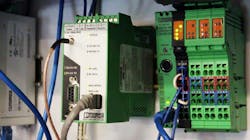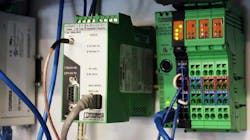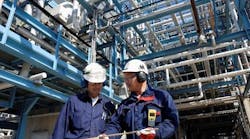In 1973, a new high-speed networking method, dubbed Ethernet, was invented by a team at Xerox led by Robert Metcalfe. In its early form, Ethernet was capable of transmitting data at a rate of approximately 2.94 megabits per second, which while essentially useless by today’s standard was considered incredibly fast at the time. With funding support from Xerox, Digital Equipment Corporation, and Intel, Ethernet evolved to become an open standard in 1976, and it experienced steady growth until it eventually became the leading networking protocol for enterprise-level data exchange.
Ethernet has subsequently jumped over the proverbial wall from the enterprise to the factory floor, achieving impressive application gains and showing significant potential in the world of industry going forward.
The Role of Ethernet for Fluid Handling
For fluid handling applications, Ethernet is important because it enables field instruments like flowmeters, valves and pressure and temperature transmitters to communicate with the control system. And as plants continue to migrate to more digital flavors of fluid handling instruments and equipment, the role of Ethernet and other industrial communication protocols grows more critical.
Currently, Industrial Ethernet’s primary competition comes in the form of a range of fieldbus and similar protocols, such as FOUNDATION Fieldbus, PROFIBUS, Modbus, HART, etc. “The whole market is split into two — one is fieldbus, the other is Ethernet,” says John Morse, senior market analyst for IMS Research. When looking at industrial networking in these terms, he says IMS currently estimates that 24.0 million new fieldbus nodes were installed in 2011 worldwide with 7.3 million new nodes for Ethernet-based technologies. However, he says the latest research shows Ethernet is growing at a faster clip than fieldbus, and he expects this trend to continue.
Key Advantages of Ethernet
Ethernet holds some compelling advantages for end-users. “The biggest factor is speed,” says Morse. “Even in its slowest form, it is still extremely fast. It also has good distance, which a lot of the fieldbuses don’t have.”
The rise of Gigabit Ethernet has made the transmission of data at 1 Gbit/s a reality. And as the story goes with technology, speeds only figure to increase with time. Further, since Ethernet is, at its roots, an open-standard protocol, there is a vast array of switches and routers it can interface with, particularly when it comes to lower-end, low-cost systems. This means end-users have more flexibility in the devices they can interface with when building Ethernet networks and, perhaps more importantly, can often deploy an Ethernet network for a lower price than fieldbus.
Another key advantage of Ethernet is that it is already widely accepted and deployed on the enterprise side. “It’s easier to link it to a corporate environment, which means you can hook your factory data into your business data more easily,” says Morse. And while he acknowledges that this may in some cases be a curse in disguise, as conflicts between corporate IT departments and factory automation teams have been known to arise, he says the advantages of seamless sharing of data between the factory and the enterprise are undeniably beneficial.
The Issue of Determinism
Ethernet in its generic form (TCP/IP) is not a deterministic technology, which means it does not prioritize data when it places packets of information on the network. So, even though Ethernet is a tremendously high-speed networking method, it cannot, in its standard form, offer a predefined, consistent time interval for moving data from one point to another.
| Ethernet for Everyone
EtherCAT: Designed to minimize delay and provide a level of determinism for applications that need a reliable and defined high-speed network (e.g., motion control in valve applications). EtherNet/IP: Designed to handle large data volumes at 10/100 Mbps, with up to 1,500 bytes per packet. The protocol was developed in the 1990s by Rockwell Automation and is now managed by ODVA (odva.org). ETHERNET Powerlink: Uses a mixed polling and time-slicing mechanism to provide guaranteed transfer of time-critical data. Also professes to provide sub-microsecond synchronization of nodes. Modbus/TCP: This is a Modbus variant used for communications over TCP/IP networks, connecting over port 502. It does not require a checksum calculation as lower layers already provide checksum protection. PROFINET: This is an Ethernet-based variant of PROFIBUS, which is touted as “real-time” Ethernet. It is a good fit for Siemens-based PLC scenarios. Sercos III: An open, IEC standardized variant of the Sercos bus system, which combines Ethernet and previous Sercos designs to provide deterministic bi-directional real-time motion and I/O control. |
“The problem with [standard] Ethernet is if you put data on the Ethernet line, you don’t know for sure what the time is to the next node,” says Morse. For some applications, like motion control, this limitation is problematic. To overcome this obstacle, several Ethernet-based protocols have emerged that prioritize data and are virtually deterministic. These protocols include, PROFINET, EtherNet/IP, EtherCAT, POWERLINK, and Sercos III.
Although the issue of determinism is a common talking point among industry insiders, it may be somewhat overblown. With the emergence of deterministic Ethernet options, there are alternatives available for those who need a predefined response time. In addition, by most accounts, standard TCP/IP Ethernet is sufficient for a large chunk of industrial networking applications. “About half of all industrial Ethernet connections are standard Ethernet TCP/IP,” says Morse. In many networks a non-deterministic performance ceases to be an issue except for applications that are mission or safety-critical or where synchronization of networked devices is essential (e.g., servo motors).
A Role for All to Play
While there is competition between fieldbus and Ethernet for market share in the industrial networking space, it is unlikely there will be significant consolidation or a clear winner among the leading players in this arena. Many of the fieldbus associations saw the advance of Ethernet awhile back and have developed Ethernet-based versions of their protocols, allowing easy porting of the fieldbus data packets onto an Ethernet network. Examples include FOUNDATION HSE (High-Speed Ethernet), derived from FOUNDATION fieldbus, and PROFINET, derived from PROFIBUS.
Ken Austin, product marketing specialist for Ethernet Infrastructure at Phoenix Contact, says he sees Ethernet as the foundation for information exchange on industrial networks. “The beauty of Ethernet is its flexibility and adaptability," he says. "For instance we have been able to develop proxies that will allow data transport between Ethernet and the fieldbus networks. Ethernet has been developed in a way that says ‘we’re not necessarily going to replace everything, but we’re going to find a way to play with everything.’”
How to Choose the Right Networking Protocol
When Ethernet first started generating serious interest from industry back in the 1990s, Morse says one of the perceived benefits was that it would be more standardized than fieldbus. “Unfortunately, we’ve ended up with almost as many variants of Ethernet as we have with fieldbus,” he says. With this truth in mind arises the question, how should end-users evaluate the range of protocols to effectively determine which best fits their application need? Morse says the key factors to evaluate when making a decision on a networking protocol are:
- Speed of transmission
- Distance of transmission
- Required level of safety
- Cost of hardware
- Connectivity of factory to corporate network
For example, he says if a motion control application where speed and determinism are required is being evaluated, then one of the high-speed, deterministic Ethernet protocols (e.g., EtherCAT, POWERLINK, Sercos III) would be a good fit. On the other hand, if intrinsic safety is required, Morse says the appropriate protocols would likely be FOUNDATION Fieldbus H1 or PROFIBUS PA.
Morse says another factor that may influence the decision is whether the desired connectivity required is controller to controller or at the field level. For controller-to-controller connectivity, he says Ethernet is an option, but when you move out to the field, the cost of implementing Ethernet can become prohibitive, and fieldbus is generally the better fit. “What I tell anybody is engage in your traditional evaluation of your network needs,” says Austin. “Deciding on your protocol before determining your need is putting the cart before the horse.” Factors Austin says end-users should look at include:
- Speed
- Bandwidth
- Physical size of the network
- Interoperability
- Greenfield or system upgrade
- Reliability required
- Future growth needs
After end-users have done their own due diligence and identified their core needs, Austin recommends they engage with a subject-matter expert to get some more feedback prior to making a decision. In many cases, a control system is already in place, and it will heavily influence the decision on a networking protocol. “Then it comes down to the PLC,” says Austin. “If you have a Rockwell PLC, you’re probably going to go with Ethernet I/P; if you have a Siemens controller, then you’ll probably go with Profinet.”
Nevertheless, Austin says it is in the end-user’s interest to do as much research up front as possible because change is typically slow to come in industry. “The network you decide on is going to be in place for quite some time,” he says. “A company that’s installing an industrial network now may not even think about changing for 10 years or so.”
Matt Migliore is the executive director of content for Flow Control magazine. Reach him at [email protected] or 610 828-1711.



